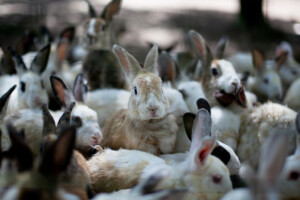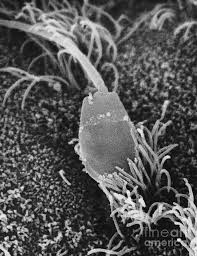Not Easter bunnies or hares, but rabbit reproduction and sperm

Fig. 1: Captive bred rabbits
There is a new focus on rabbits in terms of their so called prolific breeding rate, huge demand for rabbit meat production globally, but also ethical issues in terms of animal experimentation in medical research. Hares and rabbits are in the same family, Leporidae, but are otherwise quite different from each other. Gestation in hares is 42 days and only about 30 days in rabbits. Also rabbits are born with closed eyes and no fur and an inability to regulate body temperature. Hares on the other hand are born with open eyes and fur, have very long ears and mostly do not make burrows. Unfortunately, terminology has been inconsistent: The jackrabbit is actually a hare and not a rabbit.
So what is the historical context of rabbits? Dr Gregor Larson of Oxford indicated that: “… evidence credits the Romans with the earliest written records of rabbits” and breeding. However, “archaeological records show that rabbits were hunted during the Palaeolithic (about 3.3 million years ago) in the Iberian Peninsula and southwest France”. According to Larsen, by the Middle Ages rabbits were considered a high-status food and regularly transported across Europe. Lastly, attempts to date the timing of rabbit domestication using genetic methods were clouded by many factors such as uncertainty in the mutation rate.
Rabbits have been shown to be invaluable in medical research and apparently a good model for human reproduction but also as a food source internationally because of their prolific reproduction rate. There is a saying reproduce or breed like rabbits. Is this true? Dana Krempels states: « A single female rabbit can have 1-14 babies per litter, but let’s be conservative and say that the average litter size is six ». Also make the assumption that only half of those are females, the potential fecundity can be calculated from these hypothetical three females per litter. Rabbits can furthermore, live seven years and beyond.
Rabbit gestation lasts 28-31 days, and because they are induced ovulators (only ovulate after stimulus of copulation), the doe can be impregnated again within minutes of giving birth. Krempels, furthermore states that the doe could, hypothetically, have one litter per month if she is constantly with a male rabbit. Theoretically one house cat female can have 40,000 offspring in 7 years but rabbits dwarf this figure. if one assumes that the average litter size is six. Females would make 50% of the offspring. This means that the doe could, hypothetically, have one litter per month if she is constantly with a male rabbit. Only considering the female population, about 95 billion female rabbits will be produced in seven years (if there is no mortality)!!! Mostly this is not realistic in the context of wild populations (some endangered) and even in captive populations but at least shows the theoretical possibilities (Fig. 1).
When breeding with rabbits, it is not ideal for bucks and does to be left together for long periods of time in captive breeding situations. The doe may become aggressive towards bucks. Does have been known to castrate bucks. This may actually reflect a situation of female cryptic choice? However, in some breeding colonies, it appears that dominant males may also partly castrate rival males (usually one testis). Is this a reflection of sperm competition at a different level?

Fig. 2 Artificial vagina for rabbit semen collection and sample in Eppendorf tube.
In contrast to captive populations, the wild European rabbit only has 1 to 10 offspring annually per doe according to Zoologist Diana Bell who argues they are not “really breeding like rabbits”. The Iberian lynx almost entirely depend on rabbits for survival among many factors controlling rabbit populations.
What about semen/sperm characteristics? Litter size seems to be influenced particularly by sperm concentration and the percentage motile sperm. Rabbits produce on average 170 million sperm per day (118000 per minute). The ejaculate volume varies from 0.6 to 1 ml and semen can be easily collected using a specially designed artificial vagina (Fig. 2).
Rabbit semen consists of two main parts, gelatinous and fluid. After ejaculation, the gelatinous part fills the lumen of the vagina as a copulation plug (bouchon vaginal). The existence of a copulation plug, which prevents the semen running out of the vagina after ejaculation, has been observed in a number of mammals, particularly in rodents. It also potentially forms a barrier for copulations with other males (sperm competition).

Fig. 3: Scanning electron micrograph of rabbit sperm in oviduct.
There is furthermore about 200 million sperm per ejaculate and the sperm appears of high quality with 80% motility and 80% normal forms (Fig. 3). Some rabbits may not “reproduce like rabbits” but they certainly have very good sperm characteristics and more than plentiful sperm to reproduce very successfully, at least in captive environments and using sound breeding principles.
For research purposes it is comforting that semen collection can be done via an artificial vagina and no animals need to be sacrificed if the focus is on sperm studies post-ejaculation.
This link indicates some abnormalities of the scotum and testes in Nieu Zeeland captive bred rabbits. Some of this may be confused with castration among animals: www.researchgate.net
Prof Gerhard van der Horst (PhD, PhD)
Senior Consultant
MICROPTIC S.L.




Leave A Comment